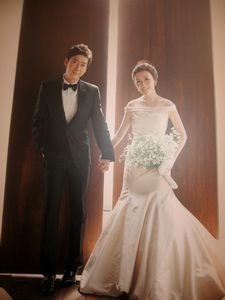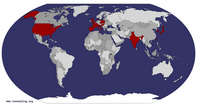Advertisement
Published: November 4th 2012

 Picture of Bride and Groom
Picture of Bride and Groom
Outside the wedding ceremonyI thought I’d fill you in on Korean heterosexual relationships. As you might expect, couple relationships in Korea tend to be different from those at home. Sometimes, these things are quite obvious. For example, often, couples in Korea hang out in public in “couple outfits”—matching clothing, which can range from only similar shoes or shirts to both wearing identical outfits. (However, there’s a saying that if a guy buys a girl shoes, she can use them to run away from him (dump him), so shoes might not be the best idea.) Public displays of affection are, however, way less common here. It’s not appropriate to kiss in public, although hand-holding is common.
Young couples don’t have much privacy though. Most people live with their parents until they’re married, even during college and after they have a full-time job. Korea has some options for those who seek privacy. There are places called “DVD bangs (rooms)”, where people can rent a movie, and watch it on a big screen in a small, private room. There are also love motels, which can be rented on an hourly or nightly basis. Some of the love motels have kind of curtains over the parking area

 Before the Walk Down the Aisle
Before the Walk Down the Aisle
You can see the bride and groom's mothers in front wearing hanbokso that people outside can’t see license plates—this is actually to protect identities of cheating spouses.
Once people become a couple, any friendships they have with members of the opposite sex usually stop or become secret. Especially women, but also men, tend to keep their partners on a tight leash. I’ve had both Korean guy and girl friends who tell me they lie to their partner about hanging out with their friends of the opposite sex. Just one example is that a guy and girl Korean—who weren’t dating each other, but each had partners, and had been friends for years—went to the jimjilbang (sauna) with a friend and I. We couldn’t take any pictures as a group or of the two Koreans together, so that their partners didn’t find out. There seems to be way less trust of one’s partner here. It’s weird because the (to me) excessive paranoid behavior causes people to lie and hide things (that don’t really need to be hidden), which makes whatever’s hidden seem bad, even if it is really just innocent friendship. I feel really bad for people with partners that are so jealous that they can’t even talk to a person of

 During the Ceremony
During the Ceremony
You can see the videographer right in the ceremonythe other sex without a scolding.
Women are kind of expected to be married by around 30 years old. Once they hit 25-6-7, if they haven’t got a serious boyfriend, their parents begin setting them up on “blind dates”. In the US, few young people would acquiesce to meeting someone their parents arranged, but in Korea, it’s pretty common. I’m not sure the bachelor/ettes like it, but they go on the blind dates to satisfy their parents. I know some Koreans who found their husbands through blind-dating, but I have other Korean friends who are really sick of going on blind dates and having their parents meddle in their relationships.
Korea has one more key aspect of many relationships that I have to write about: “aegyo”. Aegyo is a style of behavior that many young women adopt in order to seem attractive/cute/needy to their boyfriends. It’s a way of speaking that makes them sound like young children. In addition to being a way of speaking, there are tons of facial gestures and positioning hands near the face to make themselves seem cute. This is a bit representative of gender roles. In relationships, men usually pay for most meals,
coffee, etc. I can’t count the number of times I’ve walked past a woman dragging her boyfriend around while she’s shopping, and he’ll often fork over money for whatever her heart desires. Walking down the street, a boyfriend will carry a girlfriend’s purse. In the late night, men will even sometimes (drunkenly) switch shoes with their girlfriend, who complains that her feet hurt from walking in 4 inch heels all night. It seems that women can get men to do what they want, and I guess aegyo is one way that happens.
Say a couple decides they want to get married. As in many other places, the parental blessing is important. Most couples go to a fortune teller to ensure that their relationship has good karma. The fortune teller looks at when the individuals were born to predict if the union of their two families will be fortuitous. If the fortune teller says the couple/families are a bad match, or if the parents don’t like the potential mate, all deals are off.
Finally the wedding takes place. In Korea, it seems like engagements are shorter than in the US. I had a co-teacher who got engaged in June
and married in August, after meeting the guy in January! Almost all wedding ceremonies take place in wedding halls in Korea. My language exchange partner called wedding halls “couple machines” for good reason. These buildings are typically 4-7 stories tall, and one wedding takes place on each floor, at the same time. Then all the guests from all the weddings go to the banquet hall, where there is buffet. So the guests from the different weddings are all mixed up. I heard that in some halls, there are TVs playing the live wedding, so the guests, instead of watching it upstairs in real life, eat the buffet while watching the TV version.
I recently went to my first Korean wedding. It was for the sister of my good Korean guy friend. I’d never met her, but it’s not a big deal. In Korea, it’s important for your status to have many people attend your wedding, so often parents invite tons of people the bride and groom don’t even know.
The couple had actually dated since high school. They were about 32 years old, which was older for Koreans, but Jacob (the brother of the bride—Jacob is his English
name) said it was because they’d had to save a lot of money for the wedding. Also, it was odd for Korea, but they’d lived together for a year.
The wedding hall we went to was at a hotel, near a lake. It wasn’t very typical because it only had space for one wedding at a time, which was nice. We entered the lobby, where there were white envelopes. These are for the wedding present, money. You have to specify if the money is for the bride or the groom’s family. The minimum acceptable amount is about $30, but if someone is a co-worker, it would be about $50, and it only goes up from there. Also, in the lobby were many boxes of wine and fruit. I think it was wedding gifts from the bride and groom to the guests.
We went to the second floor, where the ceremony was taking place. I gave my white envelope to the bride money collector, who then gave me a meal ticket for the buffet after the ceremony. My friend Jacob was wearing a suit and looking dapper, and also looking lighter-skinned and taller than I’d last seen him. He
had used whitening cream (paler skin is more attractive here), and his mother had made him buy raised shoe inserts so she could show off her “tall” son. He was standing with his mother and his other sister and her son. The women were wearing hanbok, traditional Korean dresses.
Jacob took us back to the photography area, where his sister the bride was sitting in a “Western-style” wedding dress (it just looked like a princess-y American wedding dress). After quick introductions, we posed for a few pictures. The first ones were natural, then we did some with fingers near our faces (peace sign or something else to look cute). We then chatted in the lobby for a while.
Suddenly, we were told the ceremony was about to start, right on time. All the seats were already taken in the ceremony room, but we squeezed into the crowd standing in the back. The couple was already standing together near us, ready to walk down the aisle together. Normally, the bride is “given away” like in the US, but her father had passed away, so they chose to walk together. A worker arranged the bride’s wedding dress so it would look nice as she walked. Some Celine Dion song played as the couple walked to the ceremony spot. Once there, the couple stood facing each other about a yard apart. A worker came behind the groom and nudged him a foot back, so that he was in a good place for pictures. Actually it seemed like they were making a movie, because during the whole ceremony there was a videographer and a photographer around, and they made no effort to be out of the ceremony.
As the couple walked to the ceremony spot, people in the audience chit-chatted away. Once they got to the spot, about 10 older Korean men and women stood up and left. “They’re going to eat,” Jacob said. It was surprising that they’d stayed probably a minute into the ceremony, and it was perfectly acceptable for them to just walk right out in order to eat. People continued to come and go throughout the 15-minute ceremony. The main speaker was a “philosopher” according to Jacob. I don’t know what he talked about. There was no section of praying, which I think is the first wedding I’ve been to like that. After the philosopher had said his stuff, (without kissing or ring-exchange) the couple moved to the bride’s mother. The groom did a bow all the way to the floor to show his respect for her. Then they moved to the groom’s parents, and he did the same thing, while the bride did a tiny bow (her dress would have showed cleavage if she’d gone much lower). Next, a guest who hadn’t been part of the ceremony approached the microphone. I thought he’d give a speech, but in true Korean fashion, he sang a song to them. Apparently, this happens often at weddings.
The couple walked down the aisle while lots of people took pictures of them, and that was that. Well, that was the end of the public ceremony. Actually, next there were photos with the family, and then the private, family marriage ceremony took place. At that ceremony, the bride and groom changed to hanbok (traditional Korean clothes), to match their families. Usually, the bride’s family wears pink and the groom’s family wears blue. The families exchange money as a sign of respect for each other. The groom’s family traditionally pays for a house/apartment, and the bride’s family usually pays for all the furnishings. Also, at that ceremony, someone throws chestnuts and jujubes (like dates) at the bride, and she has to catch them in a kind of apron/skirt she’s wearing. The numbers of each that she catches is supposedly how many sons/daughters she’ll have.
After the modern ceremony, our group went to the buffet, which was a good spread of both Korean and Western food (well, at least bread, spaghetti, and salad). Then we took a walk around nearby Suseong Lake because it was a nice day.
Takeaway message: although most Koreans now have what they consider more "Western-style" relationships and weddings, they're certainly different from the American relationships I know about.
Advertisement
Tot: 0.122s; Tpl: 0.012s; cc: 13; qc: 60; dbt: 0.0713s; 1; m:domysql w:travelblog (10.17.0.13); sld: 1;
; mem: 1.2mb










